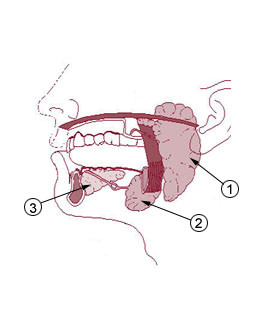Pleomorphic Parotid Adenoma (Benign Tumor of the Parotid Gland)
There are three pairs of salivary glands in the mouth which produce mucoid and serous fluids known as saliva. The largest of these glands are the parotid glands, with one located on each side of the face. The parotid gland roughly resembles an inverted pyramid. It is located behind the angle of the jaw, slightly in front of and below the ear with its base in line with the zygomatic arch (cheekbone) and apex behind the angle of the mandible. Its size and location requires it to be flexible to some degree and this is achieved by fatty tissue between its lobes with an outer fibrous capsule that contains all the structures within one mass. A large duct passes out of parotid gland and carries saliva into the oral cavity. Like any structure in the body, the parotid gland is prone to the formation of abnormal growths which may either be benign or malignant. One of the most common of these tumors in the parotid gland is a pleomorphic adenoma.
What is a pleomorphic parotid adenoma?
A pleomorphic parotid adenoma is the most common benign tumor of the parotid gland which is also referred to as a mixed tumor because it involves more than one type of cell that makes up the parotid gland. Pleomorphic adenomas are not unique to the parotid or other salivary glands, and may be found in any of the various glands in the body. The term pleomorphic simply means that it is composed of more than one cell type, whereas tumors are generally an overgrowth of a single cell type. Pleomorphic adenomas account for 60% to 80% of all tumors of the parotid gland. It may also occur in the submandibular glands although it is less common and is very rarely seen in the sublingual glands and accessory salivary glands.
The Salivary Glands
(1) Parotid gland
(2) Submandibular gland
(3) Sublingual gland
Picture from Wikimedia Commons
The basic structure of the parotid gland are groups of secretory cells that are jointly known as acinar (plural ~ acini). The secretions from these acini drain into ductules which eventually empties into the parotid duct and is secreted when stimulated by parasympathetic fibers. The parotid glands almost entirely secrete only a serous fluid which is thin and clear.
Embedded within the parotid gland are several important structures of the head and neck, including the parotid plexus of the facial nerve (CN VII), retromandibular vein and external carotid artery. A mass within the gland can therefore impinge on any of these structures thereby leading to a host of secondary effects and other clinical features.
Histopathology and Video
Pleomorphic adenomas are usually well-demarcated round tumors, most of which are encapsulated. These masses rarely exceed 6 centimeters (just under 2.5 inches) in diameter. Sometimes the capsule of the adenoma is not completely formed and this allows protrusions from the mass to extend into the surrounding parotid tissue. This makes surgical removal of the entire tumor difficult. Pleomorphic adenomas are composed of a mixture of ductal epithelial and myoepithelial cells that are arranged in a wide array of formations resembling ducts, acini, sheets, strands or tubules. Amidst these cellular arrangements are islands of hyaline, chondroid (cartilage) and rarely even osseus (bone) tissue.
Cancer in Pleomorphic Adenomas
Despite the fact pleomorphic adenomas are benign, it is possible that a malignancy can occur within the benign mass and is then referred to as carcinoma ex-pleomorphic. These cancers are extremely aggressive with a high mortality rate. Carcinoma ex-pleomorphic adenomas are more likely to arise with a benign tumor existing for a longer duration. Unfortunately pleomorphic adenomas itself are painless and slow-growing tumors and may therefore be missed for long periods of time. This ultimately increases the chances of carcinoma ex-pleomorphic arising, with an incidence of 2% in pleomorphic adenomas existing for 5 years and around 10% for tumors existing for up to 15 years.
Causes of Pleomorphic Parotid Adenomas
The exact cause is unclear but there have been certain risk factors that have been identified for both benign and malignant tumors of the parotid gland.
- Radiation.
- Cigarette smoking.
- Viral infections of the parotid gland.
- Excessive use of mobile phones but this has not been conclusively verified.
Other diseases of the parotid gland may be a contributing factor but specific causes have not been isolated. Read more on parotid gland swelling and parotitis.
Signs and Symptoms
Pleomorphic adenomas are slow-growing masses that are painless. It may eventually be palpated as a discrete mobile mass in the gland. Pain may be due to complications as the tumor compresses surrounding structures. Although more common with malignancies, tumors may affect normal saliva secretion, damage part of the facial nerve (palsy) or lead to suppuration or bleeding (hemorrhage).
Diagnosis
Computed tomography (CT scan) and magnetic resonance imaging (MRI) are the preferred methods of investigation, however, both techniques and particularly CT scan may have its limitation. Radiation exposure may want to be limited and an ultrasound examination of the gland can often prove highly useful in mapping out the size and distribution of the tumor. Although an MRI may be sufficient for differentiating a pleomorphic adenoma from other growths, dual isotope imaging by a single-photon emission CT (SPECT) may be preferred in this regard. A biopsy should be conducted to exclude malignancy.
Treatment
Surgical resection of the tumor or partoid gland (usually partial) is the mainstay of treatment. Enucleation is effective but there is about a 25% chance of recurrence particularly when there is protrusions of the tumor in the event of an incompletely developed tumor capsule. Recurrence with a parotidectomy (surgical removal of the parotid gland) on the other hand is as low as 5%. Overall, however, recurrence with a pleomorphic adenoma is low.






